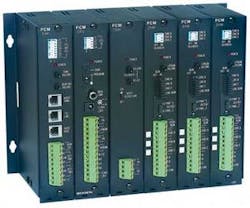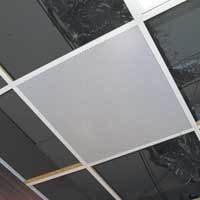Still-popular analog paging systems have adapted to meet user demands.
Over the past five years, the market for paging systems has grown substantially as customers realize the value of effectively alerting everyone in a building during an emergency.
“Paging is the absolute best way to notify everyone,” says Dennis Causey, national accounts manager with Valcom (www.valcom.com). “If there’s an e-mail virus, for example, you can immediately inform people not to open any e-mail. Many people tend to disregard or downplay fire alarms but pay more attention to a voice telling them to quickly evacuate a building. A company may only use their paging system a few times a year, but in today’s society, those few times could save lives and a tremendous amount of money.”
“Attention, shoppers...”
Paging systems first came on the scene during World War II, when United States manufacturing plants were mobilized to build military products, and the ability to make announcements and play motivational music was deemed necessary. Since then, paging and alert systems have become common in offices, schools, factories, and retail establishments as a means of locating people, making facility-wide announcements, indicating shift and class changes, or playing background music.
Traditional 70-volt centralized and 24-volt self-amplified paging systems continue to be the systems of choice. Understanding the differences between the two, their benefits, and the newest features of each can help you decide what is best for your specific environment. These systems, like many other facets of security, are facing the Internet Protocol (IP) revolution. (IP-based paging and alert systems will be addressed in a follow-up article in the February 2007 issue of Cabling Installation & Maintenance.)
Cabling and cost
Traditional paging systems consist of 70-volt centrally amplified systems and low-voltage (24-volt) self-amplified systems. A 70-volt system includes a central amplifier with cable runs to individual speakers, while a low-voltage system features amplifiers built into individual speakers. Both systems offer the same basic functionality, but cabling, price, and expansion capabilities can vary.
“In general, we see most professional sound contractors implementing centrally amplified systems,” says Dave Chambers, senior vice president of sales for Bogen Communications (www.bogen.com), a manufacturer of 70-volt and 24-volt systems. “Centrally amplified systems are easy to lay out and easy to calculate how much amplifier power you need. Many voice and data contractors today deploy self-amplified systems because they use the type of cable they’re used to using. Our stance is that you need to weigh every aspect: cost of speakers, amplifiers, cabling, and labor.”
Most vendors of 70-volt centrally amplified systems recommend the use of 18-AWG shielded cable to avoid picking up interference from nearby electrical devices. When unshielded cabling is used, interference can cause distracting clicks and hums in the speakers. Additionally, 70-volt systems with talkback features for responding to a page should always use shielded cable.
While the cost of a speaker for a 70-volt system is less than that for a low-voltage system (approximately $10 to $20 difference per speaker), the increased material and labor costs of shielded cabling are also considerations.
Self- or centrally-amplified?
“In a small system with a handful of speakers, low-voltage self-amplified makes sense,” says Chambers. “However, given the differences in cabling and speaker costs, when you have eight or more speakers, it starts to become more economical to deploy a centrally amplified system.”
Low-voltage self-amplified systems consist of 24-volt power supplies and a central controller for setting tones and features. The number of power supplies required for these systems depends on the total number of speakers and cabling distances. Low-voltage self-amplified speakers are connected with standard unshielded twisted-pair voice/data cabling.
“Most companies are already using structured cabling for their voice and data, so it often makes sense to use that cabling rather than using a system that requires shielded cable,” says Valcom’s Causey. “Self-amplified speakers require one pair for audio and one pair for power, but you can daisy-chain several speakers off of one power supply or twist the extra pairs to extend the power distance.”
Causey disagrees with the idea that self-amplified systems are not cost-effective for larger installations. “We find it to be the total opposite,” he says. “The bigger the system, the more sense it makes to use self-amplified. Nothing is as flexible as a low-voltage system. As long as you have power supplies, you can add miles of speakers and horns. With 70-volt systems, you have to add more amplification every time you want to add speakers.”
Valcom, which provides low-voltage self-amplified systems under the Valcom brand and 70-volt centrally amplified systems under the Clarity and PagePac brands, says studies have also shown self-amplified systems to be more reliable and cost-effective. “The only time I believe it makes sense to use a 70-volt centrally amplified system is when the customer already has one in place, it’s working fine, and they just want to add a few more speakers,” Causey says.
Regardless of whether you prefer a 70-volt centrally amplified system or low-voltage self-amplified system, market trends and new features continue to emerge.
Features and trends
Lay-in ceiling speakers that replace 2 x 2 ceiling tiles have become increasingly popular, even though they are more costly than smaller round speakers. “A lay-in ceiling speaker can be installed in 5 to 10 minutes, while traditional ceiling speakers require cutting holes and adding support, which can take up to 45 minutes per speaker,” explains Causey. “For that reason, most of our installers don’t even charge more for the lay-in ceiling speakers.” He adds that lay-in ceiling speakers also sound better because they have a better baffle and enclosure.
Currently accounting for about 10% of the market, zone paging is another growing trend. “Customers are starting to realize that it’s not necessary to burden everyone with all-call capabilities,” says Chambers. “For example, if 90% of your pages go to a warehouse, you can implement zone paging and reduce office pages by 90%.”
Valcom offers one-, three, and six-zone controllers for their self-amplified systems, as well as a 24-zone expansion unit. You can connect as many as three of these units to provide 48, 72, or 96 zones of paging.
Bogen also offers zone paging for self-amplified systems. While zone paging is also available with centrally amplified systems, there are limitations. “With a centrally amplified system, you can page to a specific zone, but because you have one amplifier, you can’t keep background music on in other zones,” explains Chambers. “If you want simultaneous sound in separate zones, you need an amplifier for each zone.”
If you’re looking to expand a 70-volt centrally amplified system with low-voltage self-amplified speakers, Valcom offers an expander that connects to the amplifier output on a central amplifier. Self-amplified speakers can then be added using standard UTP cabling. “If a customer asks their voice-and-data installer if they can page through the system out to one location on a dock, they’d almost surely put in a self-amplified speaker because it can connect to the UTP cable already being installed,” says Chambers. While a low-voltage self-amplified system can be added to a 70-volt centrally amplified system, the reverse is not possible.
Another feature of self-amplified systems is the ability for the speakers to continue functioning even if one speaker malfunctions. “If the amplifier in a 70-volt centralized system goes down, the whole system goes down,” says Causey. “A lot of companies also think that when the phone system is down, paging is down. With a self-amplified system, all you have to do is plug a single-line analog phone into the main control unit, and paging is still possible.”
Another recent trend in paging systems is the need for supervised systems that detect and report when an individual speaker is not working correctly. “The need to know when a specific speaker goes out is now a requirement in some OSHA applications, so we’re seeing more companies ask for that capability,” says Causey.
Application acuity
For a paging and alert system to function properly and effectively notify people, it must be properly designed for its application. Ceiling height, ambient noise, and zone requirements are all critical aspects to be considered.
“Sometimes, people try to cut costs by adding just a couple of speakers and turning up the volume, but it’s one of the worst mistakes,” says Causey. “When speakers are turned up too loud, it’s annoying for people who sit near the speakers. It’s much better and pleasing to properly space and adjust speakers based on ceiling height and the surrounding ambient noise.” Valcom does not recommend placing speakers in small offices, but says that they should be placed in hallways, cafeterias, or other places where people tend to congregate.
“Occasionally, we’ll get telephone people who will think they don’t need a paging system because there’s a speaker in every phone,” says Chambers. “It doesn’t make sense to page through telephone speakers. Why would you want to bother people who are sitting by their phone when typically the person you’re trying to page is away from their phone?”
Speaking of revenue
Despite differences between 70- and 24-volt paging systems and application requirements, everyone agrees that low-voltage systems offer additional revenue for voice and data cabling contractors. “[The cost of] a paging system is about 60% installation and 40% hardware and, therefore, an ideal way for voice and data contractors to make more money,” says Causey.
“When we first saw voice and data contractors installing paging systems because they were there first, we told these contractors not to walk away from paging,” says Chambers. “It’s an extra dimension to their revenue and less competitive than other markets. The result is that most of today’s simple, straightforward applications are installed by the same people installing the phone systems.”BETSY ZIOBRON is a freelance writer and regular contributor to Cabling Installation & Maintenance. She can be reached at: [email protected].





